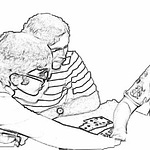
June 6 - June 15, 1942.
Summary:
Sophie Scholl’s “reminder” letter, asking her parents to send her bicycle, does not contain much cheery news. She will not be able to gain an exemption for munitiions work in August. Seems to withdraw from her family.
Willi Graf takes the advice he gave his younger sister and accepted his friends in the Siegfried Strasse as they were, with lower expectations. He no longer expects them to listen to his nightmares from the Russian front. As a result, he regains those people and that place as “safe haven” from Nazi thought.
June 13, 1942, first meeting between Hans Scholl and Willi Graf. Willi notes it in his diary. No fanfare, just a new friend.
Schneiderhan concert, violin concertos. Since Willi played in a string quartet, this music speaks to him, especially Beethoven violin concerto.
Willi also reconnects with another person from New Germany named Sigi Östreicher. Sigi allows Willi Graf to talk and talk. They read Guardini together. Sigi is willing to debate the issue of whether it is proper to become an officer in the Wehrmacht. This topic had bothered Willi Graf for months.
Traute Lafrenz and Hans Scholl break up. She recognizes that she still loves him, but it’s unrequited. She blames herself for Hans’ inability to connect, for his inattention, for the times he would “forget.” Despite the unpleasant break-up, she cannot stay away, because Alexander Schmorell, Christoph Probst, Sophie Scholl, and Hans were her safe haven.
2007 update, Alexander Schmorell: We learn that by mid-June they had developed the leaflet strategy. Specifics still had to be ironed out, but they knew what they were going to do. Alex is as frustrated as Sophie about the inaction.
2007 update, Fritz Hartnagel and Sophie Scholl: Fritz is still stationed in Mariupol, but had to travel to Kharkiv in a Fieser Stork aircraft. They were installing communication equipment on the front lines in anticipation of the next German move in the war. Fritz enjoys the aerial view of Ukraine, but struggles with his position as an officer. He tells Sophie that he feels like he belongs somewhere else.
Why This Matters:
Willi Graf’s acceptance of his friends as they were and willingness to let them be? Good example for us in 2024. Unlike Hans Scholl, Willi did not associate with known Nazis. His problem with Fritz Leist and Emil Martin had been that they would not take action against the Nazis. He knew they hated Hitler as he did. Once he quit pushing them, they began to open up — a little — and were more receptive to his conversation.
I am struck every time I work on this material how little world power dynamics change. In 2024, we are right back in the middle of things in Mariupol and Kharkiv and the Dnieper River. The historical bases of conflict in the region seem to be ignored as we seek solutions.
Have you ever chosen to accept close, trusted friends where they are, without trying to change them? What was your experience?
White Rose History, Volume II, pages 51-54.
Notes and references
Sophie Scholl:
Jens, Inge (Ed.). At the Heart of the White Rose: Letters and Diaries of Hans and Sophie Scholl. Translation by J. Maxwell Brownjohn. New York: Harper & Row Publishers, Inc., 1987.
NJ1704, Volume 7. 2/27/43 interrogation of Kurt Huber.
Willi Graf - Siegfriedstrasse friends, 6/13/1942 meeting with Hans Scholl, Wolfgang Schneiderhan concert, Sigi Östreicher discussion re officer status:
The Knoop-Graf/Jens book includes Willi’s diary entries only from this date forward. Jens observes that Willi Graf probably knew Hans Scholl before that date. However, both she and Knoop-Graf maintain that June 13, 1942 marked the first day that Willi and Hans got to know one another well enough for Willi to ascertain Hans Scholl’s political mindset.
Eckhard Holler interviewed Hans Böhler and does not believe that Hans Böhler ever made the connection between his old bündische leader Hans Scholl and New Germany friend Willi Graf.
Willi’s meeting Christl or Alex at Master Knapen’s fencing is unlikely, since Willi Graf said Hans Scholl introduced him to Christoph Probst at a concert. However, that may have been a cover to distract attention away from fencing activities, since most of Willi’s friends in Bonn shared that pastime.
Fun fact about Wolfgang Schneiderhan: He re-introduced the concept of vibrato to the Vienna Philharmonic when he joined in 1937. – Willi had good taste. After the war, Schneiderhan became most famous for his performances of Beethoven’s violin concertos.
Inge Scholl censored all of Hans Scholl’s correspondence between May 5, 1942 and July 27, 1942 – the entire Summer Semester 1942. Not one letter from that period was included in the Jens Scholl book (not Inge Jens’ decision). We know nothing about Hans’ thoughts when he met Willi Graf, much less about his correspondence and diary entries as White Rose work began. This story may change a great deal once access to his letters and diaries is no longer blocked.
Cowan, Rob. “To Tremble or Not to Tremble? Giving up bad vibrations.” In The Independent (Online Edition), August 2, 2002, retrieved from http://enjoyment.independent.co.uk/ music/features/ story.jsp?story=320594. Wolfgang Schneiderhan.
Holler, Eckard. “Die Ulmer ‘Trabanten’: Hans Scholl zwischen Hitlerjugend und dj.1.11.” Puls (22). Stuttgart: Verlag der Jugendbewegung, 1999.
April 1995 interview with Dr. Inge Jens at her home in Tübingen.
Jens, Inge (Ed.). At the Heart of the White Rose: Letters and Diaries of Hans and Sophie Scholl. Translation by J. Maxwell Brownjohn. New York: Harper & Row Publishers, Inc., 1987.
May 1995 interview with Anneliese Knoop-Graf at her home in Bühl.
Knoop-Graf, Anneliese and Jens, Inge (Eds.). Willi Graf: Briefe und Aufzeichnungen. Frankfurt am Main: Fischer Taschenbuch Verlag GmbH, 1994.
“Leading Violinist Dies.” News Limited (Australia). Retrieved from www.news.com.au/ common/story_page/0,4057,4366%255E13781,00.html. Wolfgang Schneiderhan.
Vielhaber, Klaus. Gewalt und Gewissen: Willi Graf und die “Weisse Rose.” Würzburg: Echter-Verlag, 1963.
NJ1704, Volume 1, part 3. 2/26/1943 interrogation of Willi Graf.
Traute Lafrenz and Hans Scholl:
Lafrenz, Traute. “Bericht.” Letter to Inge Scholl, dated February 21, 1946. Unpublished.
ZC13267, Volume 6. 3/25/1943 interrogation of Traute Lafrenz. Publication in 2024/2025.
2007 update, Alexander Schmorell:
RGWA I361K-I-8808. 2/25/1943 interrogation of Alexander Schmorell.
2007 update, Fritz Hartnagel and Sophie Scholl:
Bredow, Wolfgang. Lexikon der Flugzeuge. Retrieved from www.bredow-web.de/ Luftwaffenmuseum/Historisch/Fieseler_Storch.
Hartnagel, Thomas (Ed.). Sophie Scholl, Fritz Hartnagel: “Damit wir uns nicht verlieren”: Briefwechsel 1937-1943. Frankfurt am Main: S. Fischer Verlag, 2005.

This is the last FREE podcast (serialized audio book), except for occasional segments that need a wider audience, such as the three White Rose trials.
I will continue to post a free, very short excerpt with each segment. Also, free subscribers will be able to read the segment summary and Why This Matters, but not the bibliography.
Please join our work! We need every single reader! You may not realize how you fuel our work…
Podcast © 2024 Denise Elaine Heap. White Rose History, Volume II, Chapter 04, © 2002, and 2007 update © 2007, Denise Elaine Heap and Exclamation! Publishers. Please contact us for permission to quote.
This podcast is a project of WHY THIS MATTERS, a newsletter of Center for White Rose Studies, that explores the reasons that voices silenced more than eighty years ago still speak to us today.
To order digital version of White Rose History, Volume II, click here. Digital version of White Rose History, Volume I is available here.











